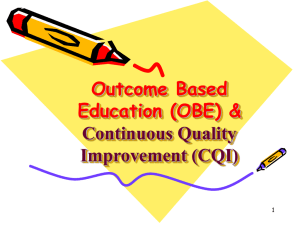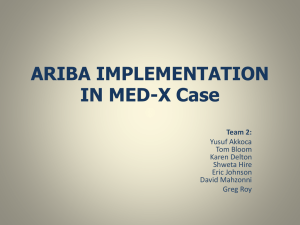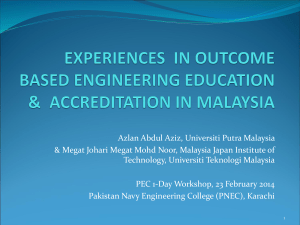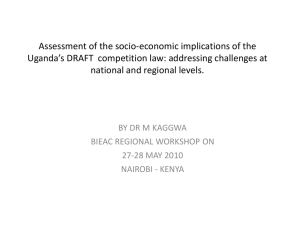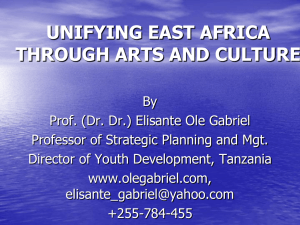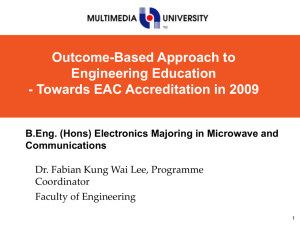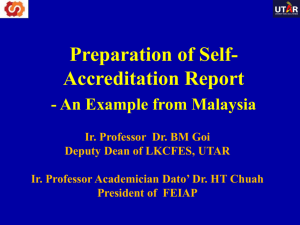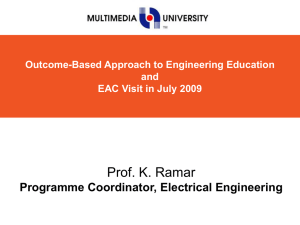Information of B.Eng (Mech)
advertisement
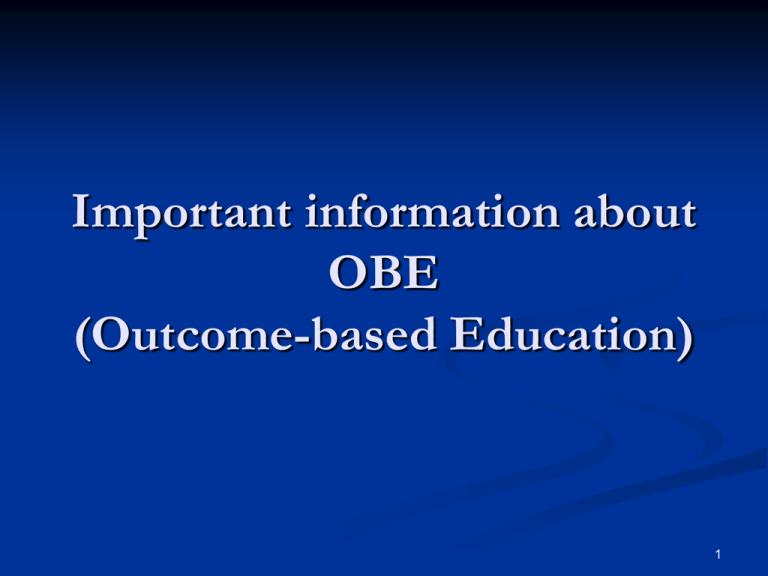
Important information about OBE (Outcome-based Education) 1 Washington Accord The Washington Accord is an international accreditation agreement for professional engineering academic degrees, between the bodies responsible for accreditation in its signatory countries. The signatories as of 2010 are Australia, Canada, the Republic of Ireland, Hong Kong, Japan, New Zealand, Singapore, South Africa, South Korea, Taiwan, Malaysia (2009), the United Kingdom and the United States. The agreement recognizes that there is substantial equivalency of programs accredited by those signatories. Graduates of accredited programs in any of the signatory countries are recognized by the other signatory countries as having met the academic requirements for entry to the practice of engineering. Recognition of accredited programs is not retroactive but takes effect only from the date of admission of the country to signatory status. 2 For Malaysia All engineering degrees are accrediated by Engineering Accreditation Council Malaysia (EAC) (http://www.eac.org.my/) Membership of the EAC comprises five (5) stakeholders namely, the Board of Engineers (BEM), the Institution of Engineers Malaysia (IEM), Industry Employers, Malaysian Qualification Agency (MQA) and the Public Service Department (JPA). 3 Outcome-based Education To join Washington Accord, the engineering degree need to adapt “outcome-based education” method. 4 OBE addresses the following key questions: What do you (lecturer) want the students to have or able to do? How will you (lecturer) know what they have achieved it? How do you (lecturer) close the loop 5 Outcome-based Education Focuses on student learning by: Using learning outcome statements to make explicit what the student is expected to be able to know, understand or do; Providing learning activities which will help the student to reach these outcomes; Assessing the extent to which the student meets these outcomes through the use of explicit assessment criteria. 6 Implementation of OBE Program • Effective Program Educational Objectives. • Effective Program Outcomes. • Practical Assessment Tools. • Effective Assessment Planning. • Robust Evaluation Planning. • Continuous Quality Improvement (CQI) procedures in place 7 Characteristics of OBE curricula It has program objectives, program outcomes, course outcomes and performance indicators. It is objective and outcome driven, where every stated objective and outcomes can be assessed and evaluated. It is centered around the needs of the students and the stakeholders. 8 Characteristics of OBE curricula (cont…) Every learning outcome is intentional and therefore the outcomes must be assessed using suitable performance indicators. Program objectives address the graduates attainment within 3-5 years after their graduation. Program outcomes, which consist of abilities to be attained by students before they graduate, are formulated based on the program objectives. 9 Programme Objectives (PEO): (Mechanical) To develop technically competent mechanical engineers well-trained in basic principles so that they are able to adapt to technological advancement. To produce broad-minded mechanical engineers who are able to manage well in technology as well as in human relations. 10 Programme Objectives (PEO): (Telecommunications) To produce all-rounded engineers in the telecommunications technologies in support of the emerging ICT industry. To develop capable technical leaders who are able to spearhead the advancement of telecommunications in the country 11 Programme Objectives (PEO): (Bio-Instrumentation) To produce engineers of high calibre who will lead, facilitate and support the development of biotechnology, health, and life sciences industries in Malaysia. To spearhead and enhance the efficiency of wealth creation via the biotechnology, health, and life sciences industries of Malaysia. 12 Programme Outcomes (PO): 1. 2. 3. 4. Ability to acquire and apply fundamental principles of science and engineering. Capability to communicate effectively. Acquisition of technical competence in specialised areas of engineering discipline. Ability to identify, formulate and model problems and find engineering solutions based on a system approach. 13 Programme Outcomes (PO): 5. 6. 7. 8. Ability to conduct investigation and research on engineering problems in a chosen field of study. Understanding of the importance of sustainability and cost-effectiveness in design and development of engineering solutions. Understanding and commitment to professional and ethical responsibilities. Ability to work effectively as an individual, and as a member/leader in a team. 14 Programme Outcomes (PO): 9. 10. 11. Ability to be a multi-skilled engineer with good technical knowledge, management, leadership and entrepreneurial skills. Awareness of the social, cultural, global and environmental responsibilities as an engineer. Capability and enthusiasm for selfimprovement through continuous professional development and life-long learning. 15 Learning Outcomes (LO) Outcomes that are expected from a certain subject and these are assessed and evaluated through various measurement tools. 16 EAC’s visit Will check on Exam scripts/assignments/ lab reports EAC’s documents Labs and experiment equipments Facilities such as lecture hall, library, etc… Lecturer and staffs Students And others… 17 http://www.eac.org.my/web/list_accredited.html http://www.eac.org.my 18
